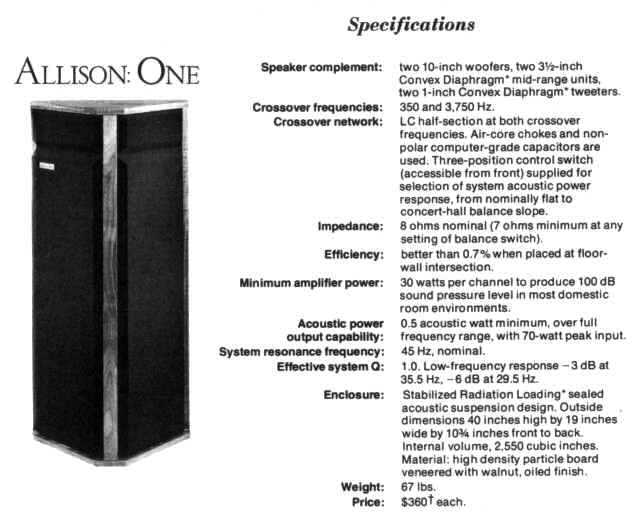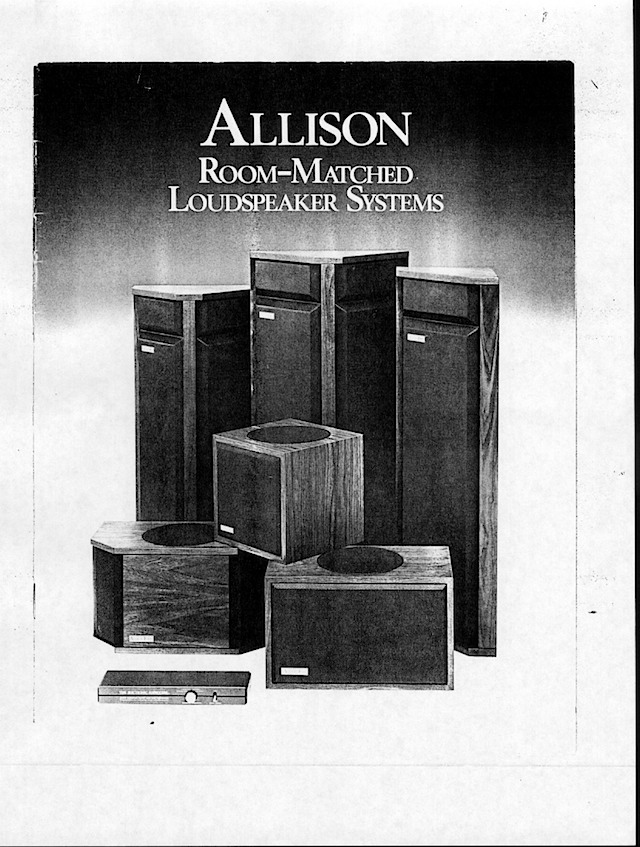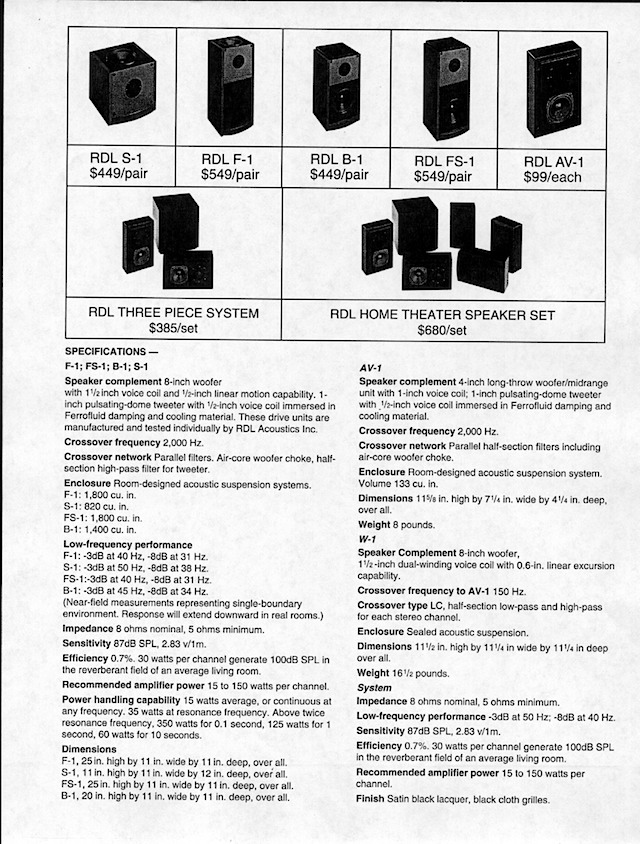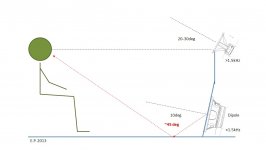for my part I am highly sceptical
for some reasons Allison Himself didn't try it in His commercial designs -when the crossover point is set at 350 Hz one can hardly say that the midrange is floor coupled

actually Allison Four, Five and Six were all flooders <2 kHz (not floor coupled but flooders anyway - they projected the sound in such a way as to flood ie. illuminate the ceiling and the upper part of the listening room evenly)

so were later CD 6 and CD 7
An externally hosted image should be here but it was not working when we last tested it.
and also RDL-S1 and F-1

Last edited:
very unclear, what did I mean?



well, let's try again - in other words - the reflected sound must be consistent with the direct sound in the time domain, the shape of the reflected wavefront must be essentially similar to the shape of the direct wavefront
it is not about faithfully reproducing square waves or about reproducing a single step response
I hope it is more clear now

how do you achieve that in real rooms? It would mean bare walls, hard and smooth, a receipe for sonic disaster!
But I don't think we need "high directivity" at all!
But we do need high directivity in the range below 1kHz, IF we want to reproduce ITD cues in a small listening room.
What we need instead is a directivity which allows us to send some more energy in one direction and some less in another
All the speakers except omnis do that, so what's the difference ?
...aimed at the listener? You mean tweeter perceivable as a tweeter? Splitting images, HRTF and pinna errors?
No ! Away such a heresy ! But using
more or less tilting
in this case towards the ceiling.
- Elias
how do you achieve that in real rooms? It would mean bare walls, hard and smooth, a receipe for sonic disaster!
Good point, since any non-mirror like surfaces cause waveform difraction and phase coherence is lost (the working principle of a diffusor).
Maybe it is possible to have the few first reflections reflected from naked walls. Later reflections will be diffracted numerous times of course and their phase and waveform is ambiguous.
- Elias
so ideally we want a dipole up to 800-1k, then a ceiling firing tweeter on a hinge, so we can adjust the effect?
BINGO !
I did some tests last night and it seems very promising concept !
Or possibly a cardioid instead of dipole, or an array to gain high directivity, or even a second order gradient radiator (seen only once of such a thing).
- Elias
I did actually tried that when I moved houses a year ago, pure concrete walls. It's a disaster really, I have now to add diffraction, so it does not work I am afraid. But yes, one could try to leave the front wall, and treat the side walls starting behind the listening position, back wall fully dead.
My first built Orions are showing signs of wood distress (used the wrong material), I need to have another go at them. I could recycle the old baffle divinding the tweeter section with two hinges on the side.. Mmmmm interesting!
My first built Orions are showing signs of wood distress (used the wrong material), I need to have another go at them. I could recycle the old baffle divinding the tweeter section with two hinges on the side.. Mmmmm interesting!
But we do need high directivity in the range below 1kHz, IF we want to reproduce ITD cues in a small listening room.
Am I to understand that You have scrapped the SSS project because of that?
Was it unable to reproduce the ITD cues?
All the speakers except omnis do that, so what's the difference ?
"the shape of the reflected wavefront must be essentially similar to the shape of the direct wavefront"
certainly not all the speakers do that, very few multi-way actually, perhaps it's one of the reasons they generally suck
No ! Away such a heresy ! But using
so - what are You going to do?
how do you achieve that in real rooms? It would mean bare walls, hard and smooth, a receipe for sonic disaster!
"must be essentially similar"
the critical frequency range is around 400<4000 Hz
It would mean bare walls, hard and smooth, a receipe for sonic disaster!
how so? quite typical walls of a living room suffice:
Coefficient Chart
so ideally we want a dipole up to 800-1k, then a ceiling firing tweeter on a hinge, so we can adjust the effect?
perhaps a dipole close to the floor and tilted towards the listening area
Maybe it is possible to have the few first reflections reflected from naked walls.
this is all that is needed
I did actually tried that when I moved houses a year ago, pure concrete walls. It's a disaster really,
You mean no absorption in the room???? Then yes - it must be a disaster.
But this disaster it is a question of absorption coefficient of the room and its RT60, quite a separate question.
Ah! No no, I always had extra absorbtion, but at the rear. I went from 0.6 RT to 0.4, better this way, but I also learned that whatever the RT, it's not very good to have large patches (over 1m) of wall left naked.
Phase grating from 6k up on the front sides could do the trick?
Phase grating from 6k up on the front sides could do the trick?
But we do need high directivity in the range below 1kHz, IF we want to reproduce ITD cues in a small listening room.
Unfortunately high directivity down low doesn't help with asymmetrical behavior of the room and asymmetrical setup.
Good point, since any non-mirror like surfaces cause waveform difraction and phase coherence is lost (the working principle of a diffusor).
Maybe it is possible to have the few first reflections reflected from naked walls. Later reflections will be diffracted numerous times of course and their phase and waveform is ambiguous.
- Elias
I think boundary-coupled on-wall is the better approach.
I also learned that whatever the RT, it's not very good to have large patches (over 1m) of wall left naked.
AFAIK it is most certainly not a problem in itself
This is what I did last night.
10" PA element in a small dipole close to floor slightly tilted upwards. 18sound XD125 horn at ear height tilted upwards about 20-30 degrees. Cross over 4th order LR at 1.5 kHz.
It sounds very promising ! When the tweeter is tilted upwards it gets harder to be localised as a sound source. Looks like the old wisdom of ceiling firing can be applied here too.
Good rule of thumb here: If you can see the diaphgram through the horn at the listening position, you have too much of direct sound.
Only had one of these so cannot say yet about the stereo performance.
- Elias
10" PA element in a small dipole close to floor slightly tilted upwards. 18sound XD125 horn at ear height tilted upwards about 20-30 degrees. Cross over 4th order LR at 1.5 kHz.
It sounds very promising ! When the tweeter is tilted upwards it gets harder to be localised as a sound source. Looks like the old wisdom of ceiling firing can be applied here too.
Good rule of thumb here: If you can see the diaphgram through the horn at the listening position, you have too much of direct sound.
An externally hosted image should be here but it was not working when we last tested it.
Only had one of these so cannot say yet about the stereo performance.
- Elias
Elias, I assume you have no ceiling acoustic treatment?
Ceiling is painted concrete, no treatments. So it reflects sound almost 100%.
10" PA element in a small dipole close to floor slightly tilted upwards. ... Cross over 4th order LR at 1.5 kHz.
is the directivity of the 10'' high enough to prevent the influence of the floor reflection in such a relatively upright position?
Attachments
- Home
- Loudspeakers
- Multi-Way
- The Advantages of Floor Coupled Up-Firing Speakers
